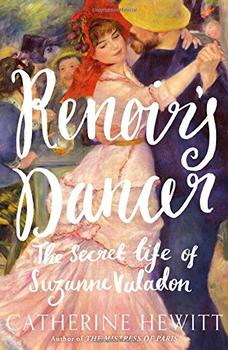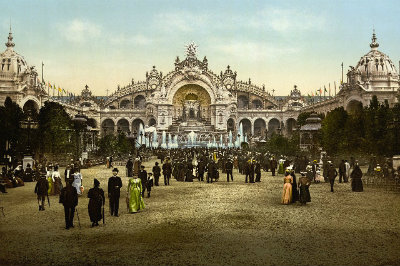Summary | Excerpt | Reviews | Beyond the Book | Read-Alikes | Genres & Themes | Author Bio

 Book Reviewed by:
Book Reviewed by:
Rose Rankin
Buy This Book
This article relates to Renoir's Dancer
The year 1789 was by no means the first time the city of Paris had experienced upheaval, but the Revolution and the decades following it were particularly tumultuous. The Terror, Napoleon, the brief restoration of the Bourbon monarchy, the Second Empire under Napoleon III: the political pendulum swung wildly and violently throughout the nineteenth century in the city along the Seine. The culmination of these events was the Paris Commune of 1871, which caused some of the worst destruction the city had ever experienced. This brief and bloody civil war, however, was followed by a remarkable period of artistic and cultural efflorescence, known as the Belle Époque.
In 1870, Emperor Napoleon III unilaterally declared war on Prussia, its much stronger neighbor, and within weeks France was defeated. Prussia then besieged Paris for four brutal months, during which time Parisians were reduced to eating dogs, cats, and rats. After surrendering territory and agreeing to pay an enormous sum of money to Prussia, Parisians turned on each other in internecine warfare.
The government left over after the defeat of the Emperor, including the remains of the French army, established themselves at Versailles, outside the city. The members of the Paris Commune, known as Communards, took control of Paris in March 1871, yet their effort to create a new social and political order that would better represent the working classes foundered on mistakes and missed opportunities. In his book, Seven Ages of Paris, Alistair Horne summarizes: "the Commune was overwhelmed by the sheer diversity of aims arising out of the mishmash of personalities, ideologies and interests that it embraced." The final confrontation between the army and the Communards in May 1871 left the city a burnt shell of itself, with mass executions of Communards and vicious killing by both sides. An estimated 20,000 people died in the conflict.
 But the years following this terrible episode in French history saw the pendulum swing yet again to the other side: rebuilding, economic expansion, national pride, and artistic flowering. The Belle Époque, the period from 1871 to the outbreak of World War I in 1914, witnessed incredible changes in cultural life, and these changes centered around Paris and its bohemian neighborhoods full of artists, writers, and intellectuals.
But the years following this terrible episode in French history saw the pendulum swing yet again to the other side: rebuilding, economic expansion, national pride, and artistic flowering. The Belle Époque, the period from 1871 to the outbreak of World War I in 1914, witnessed incredible changes in cultural life, and these changes centered around Paris and its bohemian neighborhoods full of artists, writers, and intellectuals.
Impressionist painters who had fled, including Renoir, Monet, and Degas, returned to set up studios in Paris. "Suddenly, as if in reaction against the drabness and the horrors of the siege and the Commune, the Impressionists burst forth into a passionate blaze of color, redolent with the love of simple, ordinary experience," Horne writes. Prior to the Commune, artists including Edouard Manet had already shocked the Parisian art world with avant-garde works, such as his Olympia, a portrait of an unabashed nude woman. In the 1870s the Impressionists built on these new modes of artistic expression and pioneered open-air painting, creating landscapes, cityscapes, and capturing scenes of everyday life like Renoir's Dance in the City and Dance in the Country.
This motley group of personalities challenged the mainstream art world, which they found stultifying. From Monet's watery vistas to Degas' paintings of laundresses and ballet dancers, these artists depicted life as it was happening—everyday scenes of Paris and beyond.
Female artists also made strides in being accepted as respected painters, notably Berthe Morisot and Mary Cassatt. Yet although they exhibited works in public art shows, which was a step forward for women artists, their gender still defined them before their abilities did. In her book, Impressionists, Bérénice Morvan writes of Berthe Morisot, "With respect to her painter friends, the Impressionists admired her work as a reflection of the world of women which they had but glimpsed until then."
By the early twentieth century, artists were pushing boundaries even farther, including the Fauvists led by Henri Matisse. Pablo Picasso led the Cubist movement that Cézanne had started, and Vincent Van Gogh joined the bohemian scene in the Montmartre neighborhood. All the while political pressures were building throughout the continent, from the Franco-Russian alliance rattling Germany, to French resentment of the treaty of 1871 that ceded Alsace-Lorraine to Germany, to the breakdown of historical empires and the emergence of nationalist movements around the continent.
In 1914 these pressures exploded into World War I, and the prosperous, creative world of Belle Époque Paris was destroyed. Art would of course survive, and the city would rise again from the ashes of not one but two World Wars. But for a few decades before the turn of the twentieth century, the vibrant and innovative art scene reflected the renewal of the city and the entire country, and the enjoyment of a luxurious, fun-loving peace.
Picture of World Fair of 1900 in Paris from United States Library of Congress
Filed under People, Eras & Events
![]() This article relates to Renoir's Dancer.
It first ran in the March 7, 2018
issue of BookBrowse Recommends.
This article relates to Renoir's Dancer.
It first ran in the March 7, 2018
issue of BookBrowse Recommends.





The House on Biscayne Bay
by Chanel Cleeton
As death stalks a gothic mansion in Miami, the lives of two women intertwine as the past and present collide.

The Flower Sisters
by Michelle Collins Anderson
From the new Fannie Flagg of the Ozarks, a richly-woven story of family, forgiveness, and reinvention.

The Funeral Cryer by Wenyan Lu
Debut novelist Wenyan Lu brings us this witty yet profound story about one woman's midlife reawakening in contemporary rural China.
Your guide toexceptional books
BookBrowse seeks out and recommends the best in contemporary fiction and nonfiction—books that not only engage and entertain but also deepen our understanding of ourselves and the world around us.